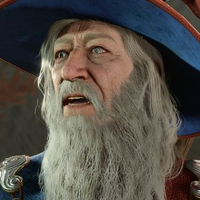Astarion has slipped a knife around my neck and wrestled me to the ground – the companion character’s customary greeting to new players of Baldur’s Gate 3. It’s a scene that’s grown familiar over years of early access and developer previews—the sense of alarm long since dulled as I roll a D20 to try and get the high-elf lunk off me.
What I’m not prepared for is the moment when he stands back up. At 5’9, Astarion looms like giant Richard Ayoade in Fable’s first trailer. Because now I’m playing a halfling—and Larian won’t let me forget it.
There are a number of mechanical advantages and disadvantages to picking a halfling during character creation. You’re considered lucky, and brave—Tolkein-esque traits that confer advantages and rerolls when getting into scrapes of one kind or another. And you can move only 7.5 metres per turn, compared to Astarion’s nine—a limitation that comes into play a dozen times over the course of a typical battle.
Yet the most striking reminder of your perspective on the world comes from Larian’s cinematic framing. Whenever I enter conversation with a human, elf, tiefling, githyanki, drow or half-orc, the camera sits behind my head, tilted upwards to meet the gaze of the other, taller party. Or it frames their lower half, cutting them off at the waist as my avatar peers into the heavens, neck permanently cricked. These scenes are never less than slick, mind you—matching Mass Effect and The Witcher for first-class shot composition. They’re simply adapted to suit my chosen protagonist, who happens to live lower to the ground than Geralt or Shepard.
This flexible mise-en-scène didn’t come easily to Baldur’s Gate 3. When I visited Ghent, the Belgian city where Larian’s oldest office is situated, creative director Swen Vincke told me that camera angles had been a source of arguments early in the game’s development. Larian’s cinematics team—many of whom are Telltale veterans, new to the studio with this project—clashed with other departments who insisted that a plethora of possible player actions be accounted for during cutscenes.
In one test encounter, for instance, a goblin threatened the player from a rooftop, a sight just begging to be framed from below. But if said goblin had been blasted by a spell or given a forceful shove beforehand, they might just as easily have dropped a couple of floors, appearing on the cobbles surrounded by blood splatters for their close-up. Consider just how many dialogue scenes play out in Baldur’s Gate 3, as well as all their potential subversions, and you begin to understand why Larian’s willingness to say ‘yes’ to the player has had enormous knock-on consequences for the team tasked with placing the camera.
See more
All that hard work, however, has yielded powerful results. Perhaps that should be no surprise. Game developers often talk about the importance of the 3Cs—character, controls, camera—which determine how comfortable it feels to steer your avatar around a game world. Only when these fundamentals are nailed can you forget about the mouse and interface – entering a flow state where you’re able to connect with a game on a higher level.
In Baldur’s Gate 3, not only does the game’s camerawork hold together under intense pressure, its flexibility actually contributes to the role-playing. In my playthrough, every meeting with an NPC is a little bit like Gandalf’s visit to Bag End in The Fellowship of the Ring. Except that rather than bumping my head on low-hanging chandeliers, I’m experiencing the opposite: becoming acutely aware that as a halfling I exist in a world built at the scale of larger-sized people. It’s a knowledge that can’t help but inform my reactions and decision-making over the course of my adventures on the Sword Coast.
I’m hesitant to make too much of this. People with dwarfism live every day with the prejudice and inconvenience caused by a world unwilling to accommodate them, and I can’t know what that’s like. Furthermore, their portrayal in games remains iffy, to say the least. It would be better if more fantasy worlds incorporated dwarfism as it is, rather than as inspiration for characters classified as non-human.
But there’s real power in the way Baldur’s Gate 3 listens to your choices in character creation and reworks the game to suit. The camera tells a story. More specifically, it tells yours, whoever you are—and that’s worth celebrating.
<a href=”https://miteinander-lernen.com/baldurs-gate-3-guide/” data-link-merchant=”pcgamer.com””>Baldur’s Gate 3 guide: Everything you need
<a href=”https://miteinander-lernen.com/baldurs-gate-3-save-mayrina-quest/” data-link-merchant=”pcgamer.com”” data-link-merchant=”pcgamer.com”” target=”_blank”>Baldur’s Gate 3 Mayrina: Save the sister
<a href=”https://miteinander-lernen.com/baldurs-gate-3-necromancy-of-thay-key-choice/” data-link-merchant=”pcgamer.com”” data-link-merchant=”pcgamer.com”” data-link-merchant=”pcgamer.com”” target=”_blank”>Baldur’s Gate 3 Necromancy of Thay: Open the tome
<a href=”https://miteinander-lernen.com/baldurs-gate-3-underdark-entrances/” data-link-merchant=”pcgamer.com”” data-link-merchant=”pcgamer.com”” data-link-merchant=”pcgamer.com”” data-link-merchant=”pcgamer.com”” target=”_blank”>Baldur’s Gate 3 underdark: How to get in
<a href=”https://miteinander-lernen.com/baldurs-gate-3-cellar-door-ornate-mirror-answers/” data-link-merchant=”pcgamer.com”” data-link-merchant=”pcgamer.com”” data-link-merchant=”pcgamer.com”” data-link-merchant=”pcgamer.com”” data-link-merchant=”pcgamer.com”” target=”_blank”>Baldur’s Gate 3 ornate mirror: Open the cellar door
<a href=”https://miteinander-lernen.com/baldurs-gate-3-where-to-find-every-umbral-gem-in-the-gauntlet-of-shar/” data-link-merchant=”pcgamer.com”” data-link-merchant=”pcgamer.com”” data-link-merchant=”pcgamer.com”” data-link-merchant=”pcgamer.com”” data-link-merchant=”pcgamer.com”” data-link-merchant=”pcgamer.com”” target=”_blank”>Baldur’s Gate 3 gauntlet of Shar: Umbral gem locations
